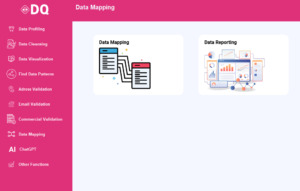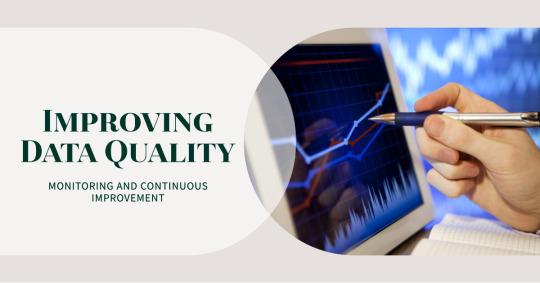#Data profiling
Explore tagged Tumblr posts
Text
#tomtanuki#invasion of privacy#privacy#australia#ausgov#politas#coles#woolworths#supermarket#auspol#tasgov#taspol#neoliberal capitalism#fuck neoliberals#anthony albanese#albanese government#spying#criminal profiling#racial profiling#data profiling#spy#defeating capitalism#capitalist dystopia#capitalist hell#capitalism#capitalist bullshit#anti capitalist#capitalistic#security camera#camera
2 notes
·
View notes
Text
Why Data Profiling Tools Are Crucial for Your Business in 2025

Have you ever felt like managing data is a huge task that takes up too much time and energy? Well, you’re not alone. We all know how important data is these days, right? But the real challenge is how to manage and organize that data effectively. And here’s where data profiling tools come in—they are a lifesaver!
In 2025, data is growing at an unimaginable pace, and with this explosion, having the right tools to stay on top of it is essential. Without the right profiling tools, you could end up with messy, inaccurate data that could harm your business. Imagine dealing with inconsistent data that leads to faulty decisions or missed opportunities. Not a pretty picture, right?
Data profiling tools help you analyze, cleanse, and organize your data, making it much easier to understand and use for your business decisions. By evaluating the quality and structure of your data, they give you the insights you need to keep things in check.
But, here’s the thing: not all data profiling tools are created equal. With so many options out there, choosing the right one can be a challenge. Whether you're a small business or a larger enterprise, you need a tool that’s reliable, easy to use, and capable of handling your data needs. That’s why we’re taking a deep dive into the top five data profiling tools of 2025, helping you make an informed choice.
Stay tuned, because in our main article, we’re going to cover the best data profiling tools you should consider for your business this year. Trust us, these tools will make your life much easier and your data management a whole lot smoother.
Curious about the top data profiling tools that will make all the difference for your business? Check out the full article here to explore the best options available for 2025!
0 notes
Text
What is Data Profiling?
Summary: Data profiling helps analyse data's structure and quality to identify issues and enhance management. It involves various profiling types and best practices, ensuring accurate, reliable, and consistent data for better decision-making.

Introduction
Data management is crucial for organisations to maintain accurate, reliable, and consistent data. Data profiling plays a vital role in this process. So, what is data profiling? It involves analysing data to understand its structure, content, and quality.
This blog aims to explain what data profiling is, its purpose, key components, and techniques. By the end, you'll understand why data profiling is vital across industries, helping to identify data issues, improve data quality, and support data integration and migration efforts.
Also Read: Time Complexity for Data Scientists.
What is Data Profiling?
Data profiling involves examining and analysing data from an existing source to understand its structure, content, and quality. You focus on assessing the characteristics of the data, such as data types, patterns, and anomalies, to create a detailed summary. This summary helps you make informed decisions about data management and improvement.
How Data Profiling Fits into the Data Management Process
Data profiling plays a crucial role in the data management process. When you integrate data from multiple sources, data profiling helps you identify inconsistencies, duplicates, and errors.
Understanding these issues early simplifies data integration and ensures smooth data flow. Additionally, data profiling aids in data governance by providing insights into data lineage, helping you track data origins, transformations, and destinations.
Importance of Understanding Data Quality Through Profiling
Understanding data quality through profiling is essential for maintaining accurate, reliable, and valuable data. When you profile data, you identify potential problems affecting data-driven decisions.
High-quality data leads to better insights, more effective strategies, and improved operational efficiency. By regularly profiling your data, you ensure it remains clean, consistent, and fit for its intended use, ultimately driving better business outcomes.
Purpose of Data Profiling
Data profiling serves multiple crucial purposes in managing and leveraging data effectively. It enables organisations to gain insights into their data, ensuring its quality, consistency, and compliance. Here are the essential purposes of data profiling:
Identifying data quality issues: Detect and address errors, inconsistencies, and inaccuracies in the data. This includes identifying missing values, duplicate records, and incorrect formats, which helps maintain high data quality.
Understanding data patterns and distributions: Analyse the statistical properties of data, such as frequency distributions, mean, median, and standard deviation. This understanding allows organisations to make informed decisions based on data trends and patterns.
Ensuring data compliance and consistency: Verify that the data adheres to defined standards and regulations. Consistency checks ensure that data across various sources and systems remain uniform, supporting accurate analysis and reporting.
Supporting data integration and migration efforts: Facilitate seamless data integration from multiple sources by providing a comprehensive understanding of data structure and content. Data profiling helps identify potential issues before data migration, ensuring a smooth transition and integration process.
Read Blog: Unlocking the 12 Ways to Improve Data Quality.
Key Components of Data Profiling
Data profiling involves several critical components that ensure a comprehensive understanding of the data. Each element is vital in assessing and improving data quality, helping organisations make informed decisions and streamline operations.
Data Assessment: This involves evaluating the current state of data within the system. It includes checking for completeness, accuracy, and consistency. Organisations can identify missing or incorrect values, data duplication, and other issues that could impact data quality by assessing the data.
Data Analysis: This component focuses on identifying patterns, trends, and anomalies within the data. Data analysis helps in uncovering underlying issues such as data inconsistencies, outliers, or deviations from expected patterns. This analysis provides insights into how data behaves and highlights areas requiring attention.
Data Reporting: After assessment and analysis, documenting the findings and insights is crucial. Data reporting involves creating detailed reports that summarise the results of the profiling activities. These reports help stakeholders understand the data quality issues and guide decisions on necessary data cleansing or improvements.
Together, these components ensure data profiling effectively enhances data quality and usability.
Types of Data Profiling

Understanding the different types of data profiling helps organisations effectively assess and improve their data quality. Each type serves a unique purpose and provides valuable insights into various aspects of data.
Column Profiling
Column profiling involves analysing individual data columns to understand their structure and content. This process evaluates data types, distributions, and statistical summaries. By examining each column, organisations can identify anomalies, outliers, and patterns that may indicate data quality issues.
Cross-Field Profiling
Cross-field profiling focuses on analysing the relationships between different fields within a dataset. This type of profiling helps uncover dependencies and correlations between fields. By understanding these relationships, organisations can ensure data integrity and identify inconsistencies arising from incorrect data mappings or missing values.
Data Rule Profiling
Data rule profiling involves validating data against predefined rules or business logic. This process ensures data adheres to specific standards and constraints, such as format requirements or value ranges. By enforcing these rules, organisations can detect and rectify data that does not meet expected criteria.
Data Value Profiling
Data value profiling examines individual data values for consistency and accuracy. This type of profiling focuses on validating data against expected patterns and norms. By analysing data values, organisations can identify errors, duplicates, and discrepancies that affect data reliability and usability.
Each type of profiling contributes to a comprehensive understanding of data quality, helping organisations maintain accurate and reliable datasets.
Data Profiling Best Practices
To maximise the effectiveness of data profiling, following best practices ensures that the process delivers accurate, actionable insights and supports robust data management. Implement these strategies to optimise your data profiling efforts:
Establish Clear Objectives: Define specific goals for data profiling, such as improving data quality, ensuring compliance, or enhancing data integration. Clear objectives guide the profiling process and align it with organisational needs.
Use Automated Tools and Software: Leverage advanced tools and software to streamline data profiling tasks. Automation enhances efficiency, reduces manual errors, and accelerates the analysis of large datasets, allowing for quicker decision-making.
Regularly Update and Review Results: Continuously monitor and update profiling results to reflect changes in data and business requirements. Regular reviews ensure that the profiling remains relevant and accurate, promptly addressing emerging issues.
Ensure Cross-Departmental Collaboration: Foster communication and collaboration among departments involved in data management. Engaging different teams in the profiling process promotes a comprehensive understanding of data issues and supports cohesive strategies for data quality improvement.
Implementing these best practices will enhance the reliability and effectiveness of your data profiling efforts, contributing to better data management and decision-making.
Further Read: Data Observability Tools and Its Key Applications.
Frequently Asked Questions
What is data profiling in simple terms?
Data profiling involves analysing data to understand its structure, content, and quality. It helps identify data issues, patterns, and anomalies to improve data management and decision-making.
Why is data profiling important?
Data profiling is crucial for ensuring data quality, identifying inconsistencies, and supporting data integration. It helps organisations maintain accurate data, improving insights and operational efficiency.
What are the types of data profiling?
The main types of data profiling are column profiling, cross-field profiling, data rule profiling, and data value profiling. Each type assesses different aspects of data to enhance quality and integrity.
Conclusion
Data profiling is essential for managing and improving data quality. Organisations can identify issues by analysing data's structure, content, and patterns, ensure data consistency, and support integration efforts. Implementing data profiling best practices ensures accurate insights, better d
0 notes
Text

Data validation is a critical aspect of ensuring the accuracy and integrity of data within various systems and processes. It involves the verification and validation of data to guarantee its reliability and usability. Imagine data validation as the gatekeeper that checks every piece of information trying to enter the system, ensuring only the correct and accurate data gets through. Just like a security checkpoint at an airport, data validation filters out the unwanted and potentially harmful data, allowing only the safe and valid data to pass through.
One of the key challenges in data validation is the sheer volume of data that needs to be processed. With the exponential growth of data in today's digital age, manual validation processes are no longer feasible. This is where automated data validation tools and techniques come into play. These tools streamline the validation process, making it faster, more efficient, and less prone to human error. It's like having a team of tireless workers who meticulously examine every piece of data, ensuring its accuracy and quality without getting tired or making mistakes.
Ensuring data accuracy is not just about maintaining the quality of information but also about upholding the credibility and trustworthiness of the entire system. Inaccurate data can lead to faulty decisions, flawed analysis, and ultimately, disastrous outcomes. Just like a single wrong turn can lead to getting lost in a maze, one incorrect piece of data can derail an entire process or system. Data validation acts as a compass, guiding the system in the right direction by ensuring that the data it relies on is accurate, reliable, and consistent.
Data validation is not a one-time task but an ongoing process that requires continuous monitoring and maintenance. As data evolves and changes over time, so do the validation requirements. Regular data validation checks are essential to identify and rectify any discrepancies, anomalies, or errors in the data. It's like regularly servicing your car to ensure it runs smoothly and efficiently. By proactively validating data on a regular basis, organizations can prevent data quality issues before they escalate into major problems.
0 notes
Text
Discover the power of data with in2in global's Data Insights services. Our expert team delivers comprehensive and actionable insights to help your business thrive.
#data science#data cleansing#data visualization#data analytics#data#data analysis#data processing#datainsights#data profiling
0 notes
Text
Spotify #Wrapped 2023
#spotify#spotify wrapped#wrapped 2023#spotify wrapped 2023#data gathering#data profiling#surveillance capitalism#big tech#corporations#music#ghost in the machine
1 note
·
View note
Text
Data Quality Monitoring and Continuous Improvement
Introduction In today’s data-driven business landscape, the importance of data quality cannot be overstated. Reliable and accurate data forms the bedrock of informed decision-making, strategic planning, and effective customer engagement. As organizations continue to gather vast volumes of data, the need for robust data quality monitoring becomes paramount. In this article, we will delve into the…

View On WordPress
0 notes
Text
What is Data Profiling?
Profiling is a crucial part of data preparation programs. It's the process of examining and analyzing data sets to gain more insights into their quality. Having mountains of data is the norm in modern business. But accuracy can make or break what you do with it.
Profiling helps you learn more about how accurate and accessible your data is while giving your teams more knowledge about its structure, content, interrelationships and more. This process can also unveil potential data projects, highlighting ways you can use your data assets to boost the bottom line.
Types of Data Profiling
There are three primary forms of profiling.
The first is structure discovery. This process is about formatting data to ensure everything is uniform and consistent. Statistical analysis can give you more insight into your data's validity.
The second type of profiling is content discovery. With the content discovery, the goal is to determine the quality of the data. It helps identify anything incomplete, ambiguous or otherwise null.
Finally, we have relationship discovery. As the name implies, it's about determining how data sources connect. The process highlights similarities, differences and associations.
Why Profiling is Necessary
There are many benefits to profiling data. Ultimately, the biggest reason to include it in your data preparation program is to ensure you work with credible, high-quality data. Errors and inconsistencies will only set your organization back. They can misguide your strategy and force you to make decisions that don't provide the desired results.
Another benefit is that it helps with predictive analysis and core decision-making. When you profile data, you're learning more about the assets you hold. You can use this process to make predictions about sales, revenue, etc. That information can guide you in the right direction, making critical decisions that help generate growth and success.
Organizations also use profiling to spot potential issues within their data stream. For example, the content discovery phase highlights errors and inconsistencies. Chronic problems may point to a glaring issue within your system, helping you spot quality data issues at their source.
Read a similar article about data glossary here at this page.
0 notes
Text
Data in Gold <3



Expand for higher qualityy
#everyone is obsessed with his profile and so am i#i should have made his lips golden too#you'll have to imagine it#it was so hard to take pics of glittery watercolour ;-;#i hope its ok#i actually had most of this sketch done since last week but i'm unstable and stressed so i forgot to post it :D#anyway i love data and i cant stop thinking about him#and data does not look like mark zuckerberg#those people need to be stopped fr lol#i dont want to hear it#brent spiner#data soong#star trek tng#thinking about drawing lore too...
420 notes
·
View notes
Text
"2020: New Orleans bans police use of #facerecognition, recognizing it to be dangerous and invasive.
2022: Crime panic causes city to reverse course and reinstate face recognition despite earlier concerns.
2023: Face recognition has led to zero arrests."
#facial recognition#invasion of privacy#privacy#data profiling#racial profiling#criminal profiling#profiling#face recognition#nola#new orleans#usa#america#australia#australian#ausgov#politas#auspol#tasgov#taspol#neoliberal capitalism#fuck neoliberals#anthony albanese#albanese government#allcopsarebastards#all cops#all cops are bastards#kill all cops#all cops are bad#rioters set fire to town hall & clash with cops as protests rage on across france after macron forced pension reform#tw cops
0 notes
Text





more of these guys ( + one deanna)
#star trek#star trek the next generation#tng#geordi la forge#data soong#data tng#daforge#tangentially. to a degree.#deanna troi#fan#2024#first and 2nd to last page are reffed from screenshots the rest are just whatever#i thnk the very first one where data's smiling might be from a blooper . unsure#I LOVE DRAWING DATA IN PROFILE!!!!!!!!!!!!!!!!!!!!!!!!!!!!!!!!!!!!!!!!!!!!!!!!!!!!!!!!!!!!!!!!!!!!!!!!!!!!!!!!!!!!!!!!!!!!!!!!!!!!!!!!!!!!!#also apparently geordi holding his hand out towards the camera. i have like three other geordi drawings where hes doing that. shrugs#queue#WHAT WHY WAS THIS POSTED TODAY ok whatever thats fine. thought i scheduled it for tomorrow but so be it#edit took 2 drawings out bc i didn’t like them actually. he would not look like that (<— said to myself)
210 notes
·
View notes
Text



indeed my exact process once every 8 months or so
#I just thought today of a new way to format a 'profile' (like the descriptions of self that people use on friend meeting#apps and stuff) and how to organize the sections so that it seems such and such a way and oh what if there's links which click off#into branching paths so it's very acessible and there are two different forms depending on so on and so forth#and i was like 'um.. wow. amazing idea. this will be soooo aweseome and will definitely work' but then .. you know...self reflection#lol.. is this just like the millions of other iterations of a similar thing? No.. This Is Different ... Surely...#Though if I had a millionaire friend and a few people who do the type of coding you use for web design stuff and etc..#I could create the most elaborate detailed and amazing platonic friend seeking (and I guess you could also have 'dating' as an option#since that would draw in more of a crowd) website on the earth.. the new okcupid (back when okcupid didn't suckishly abandon their#whole format in hopes of trying to become just like tinder or whatever and they actually had like tons of info and percentages and#open answer questions and would list personality traits on a profile (like 'this person is more Open To New Expereinces than 65% of#other users' etc.). etc. etc. Oh what a beautiful thing I could craft for the detail freaks of the world.... Alas...#unfortunately we seem to be in an oversimplification era.. everything in short quick bites. everything on a tiny phone screen. etc.#marketing 'Introducing The Most Complicated Data Heavy Social Connection Site In The World' would not sell well I'd imagine gjhgjh#AANYWAY.. also no idea why the representation of me is in a turtle neck. what a bold fashion choice..#In another moment of self reflection.. the fact that in the first tag on this post I felt the need to define the word 'profile' just to be#specific as if people couldn't tell from context.. so clearly someone who finds filling out forms a 'fun afternoon activity' lol#the type of guy who finds psych evaluations and pop quizzes and making chore lists mostly enjoyable (< true)
32 notes
·
View notes
Text

Data Profiling is a critical aspect of data management that involves analyzing and understanding the structure, content, and relationships within a dataset. By delving deep into the data, organizations can uncover valuable insights and hidden patterns that can significantly impact decision-making processes and overall data quality.
One of the key benefits of data profiling is its ability to identify data anomalies and inconsistencies. Imagine data as pieces of a puzzle scattered across a table. Data profiling acts as the keen-eyed detective that carefully examines each piece, ensuring they fit together perfectly to form a coherent picture. This meticulous scrutiny helps organizations detect errors, duplicates, and outliers that could otherwise go unnoticed.
Moreover, data profiling enables organizations to gain a comprehensive understanding of their data landscape. It's like exploring a vast and uncharted territory, where each discovery sheds light on the intricacies of the data ecosystem. By mapping out data relationships and dependencies, organizations can make informed decisions regarding data integration, migration, and transformation.
With the help of advanced tools like DataQleaner, organizations can streamline the data profiling process and uncover hidden insights more efficiently. DataQleaner acts as a trusted ally in the quest for clean and reliable data, providing automated data profiling capabilities that accelerate the identification of data issues and discrepancies.
By harnessing the power of data profiling tools like DataQleaner, organizations can transform raw data into actionable intelligence, paving the way for improved decision-making, enhanced operational efficiency, and sustainable growth. Embracing data profiling is not just about cleaning up data; it's about unlocking the true potential of data and harnessing its transformative power.
0 notes
Text
Keep your data accurate and up-to-date with in2in global's top-rated data cleansing services. Save time and resources by trusting us to clean your data effectively.
0 notes
Text

It was DEFINITELY Wednesday (when this was sent to me yesterday…oops!).
#star trek#star trek tng#tng#star trek the next generation#the next generation#data soong#lore soong#star trek data#star trek lore#strawpage doodles#those are some GOOD data and lore profiles#love how you captured their expressions! they’re so classically them
33 notes
·
View notes
Text


His side profile…
27 notes
·
View notes